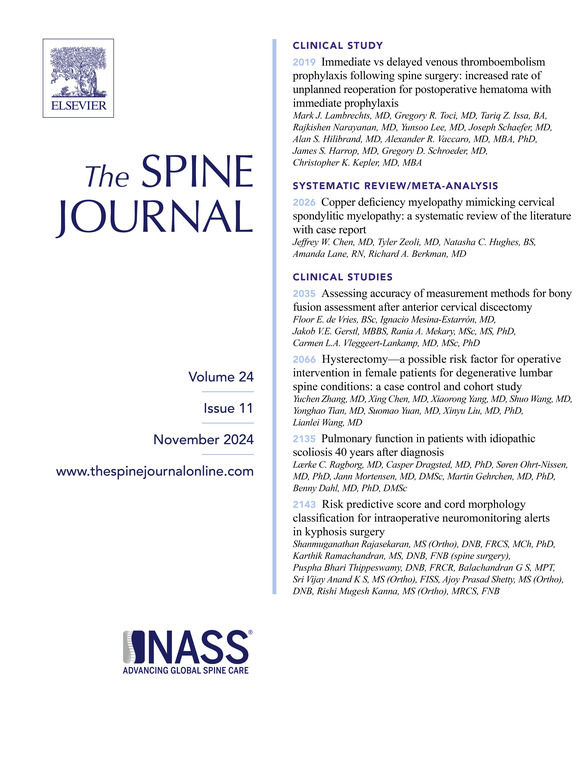Value of metagenomic next-generation sequencing in the diagnosis of native pyogenic spinal infections: a multicenter, retrospective observational study
IF 4.7
1区 医学
Q1 CLINICAL NEUROLOGY
引用次数: 0
Abstract
BACKGROUND CONTEXT
The etiological diagnosis of pyogenic spinal infection is crucial for its precise antibiotic treatment. Traditional methods of detection are often slow and ineffective. In recent times, metagenomic next-generation sequencing (mNGS) has revolutionized pathogen detection, offering a more effective approach to disease management.
PURPOSE
Comparing mNGS with microbial culture to comprehensively explore the diagnostic value of mNGS in pyogenic spinal infections.
DESIGN
A multicenter, retrospective observational study.
PATIENT SAMPLE
In a multicenter retrospective observational study, we analyzed the data from 301 patients admitted in four selected hospitals with pyogenic spinal infections from December 2019 to February 2024.
OUTCOME MEASURES
Identification of pathogenic bacteria in patients.
METHODS
Obtain blood and lesion tissue or pus samples from the enrolled patients for microbial culture, serological and hematological laboratory tests, pathological examination, and mNGS analysis, followed by a comparative analysis of the results.
RESULTS
In our cohort of 301 cases of clinically diagnosed pyogenic spinal infections, 242 yielded etiological evidence. The most common gram-positive bacterium was Staphylococcus aureus, and the most common gram-negative bacterium was Escherichia coli. mNGS showed a significantly higher rate of detection (77.9%) compared with microbial culture (27.2%) with a notable difference (X² = 140.17, P<.001). In culture-negative samples, mNGS could detect pathogens in 73.1% of cases, and in culture-positive samples, it could detect pathogens in 91.5% of cases with 94.7% genus-level concordance. mNGS provided faster results (24–48 h) compared with the culture method (2–7 days).
CONCLUSIONS
mNGS serves as a valuable supplement to the culture method and shows potential in identifying the causative pathogen in native pyogenic spinal infections.
新一代宏基因组测序在诊断原发性化脓性脊柱感染中的价值:一项多中心、回顾性观察研究。
背景背景:脊柱化脓性感染的病原学诊断对其精确的抗生素治疗至关重要。传统的检测方法往往是缓慢和无效的。近年来,新一代宏基因组测序(mNGS)彻底改变了病原体检测,为疾病管理提供了更有效的方法。目的:比较mNGS与微生物培养,全面探讨mNGS对脊柱化脓性感染的诊断价值。设计:一项多中心回顾性观察性研究。患者样本:在一项多中心回顾性观察研究中,我们分析了2019年12月至2024年2月在4家选定医院住院的301例化脓性脊柱感染患者的数据。结果指标:患者致病菌鉴定。方法:取入组患者血液及病变组织或脓液标本进行微生物培养、血清学和血液学实验室检查、病理检查和mNGS分析,并对结果进行比较分析。结果:在301例临床诊断为化脓性脊柱感染的病例中,242例提供了病因学证据。最常见的革兰氏阳性菌为金黄色葡萄球菌,最常见的革兰氏阴性菌为大肠杆菌。mNGS的检出率(77.9%)显著高于微生物培养(27.2%),差异有统计学意义(X² = 140.17,P < 0.001)。在培养阴性样本中,mNGS检出率为73.1%,在培养阳性样本中,mNGS检出率为91.5%,属水平一致性为94.7%。与培养法(2-7天)相比,mNGS提供了更快的结果(24-48 h)。结论:mNGS可作为培养法的有益补充,在鉴定天然化脓性脊柱感染的致病菌方面具有一定的潜力。
本文章由计算机程序翻译,如有差异,请以英文原文为准。
求助全文
约1分钟内获得全文
求助全文
来源期刊

Spine Journal
医学-临床神经学
CiteScore
8.20
自引率
6.70%
发文量
680
审稿时长
13.1 weeks
期刊介绍:
The Spine Journal, the official journal of the North American Spine Society, is an international and multidisciplinary journal that publishes original, peer-reviewed articles on research and treatment related to the spine and spine care, including basic science and clinical investigations. It is a condition of publication that manuscripts submitted to The Spine Journal have not been published, and will not be simultaneously submitted or published elsewhere. The Spine Journal also publishes major reviews of specific topics by acknowledged authorities, technical notes, teaching editorials, and other special features, Letters to the Editor-in-Chief are encouraged.
 求助内容:
求助内容: 应助结果提醒方式:
应助结果提醒方式:


